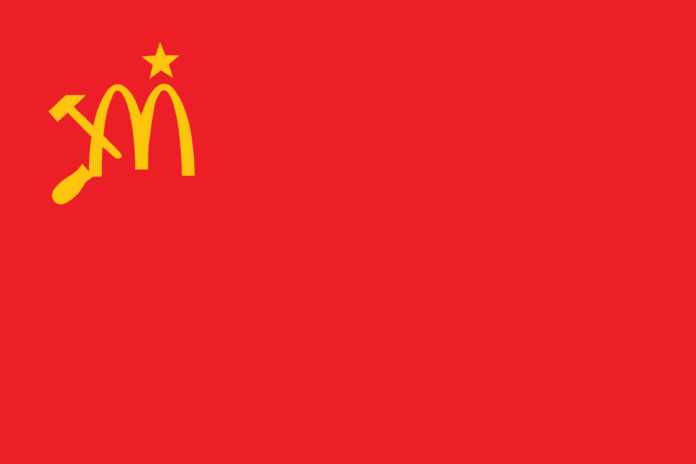What Russia’s early obsession with fast food implies
Just two years before the fall of the Soviet Union in 1991, over 30,000 customers flocked to the opening of the very first McDonald’s in Moscow. They formed a line that snaked around several blocks and waited more than eight hours. With an average salary of 150 rubles per month, a Big Mac that cost 3.75 rubles — the cost of a monthly bus pass — did not deter citizens from getting a taste of American capitalism.
“Everything tasted more intense than anything I’d ever tried before,” recounts photographer Mitya Kushelevich. “I ate and drank and chewed like it was my last meal on earth.”
In what would be the largest restaurant at the time of its opening, even setting a global record for most people served in one day, Russia’s first fast food chain stood as a clear sign that times were changing. Cold War relations were beginning to thaw.
My mom, who visited Moscow during McDonald’s opening week, recalls seeing the massive crowd. To her and many others, it was unlike anything before.
“Everyone heard a lot about America, so they wanted to see what it was all about,” my mom told me as she recounted her experience. “It was a new experience. It was good.”
Hidden behind the Iron Curtain, the Soviet Union did not allow Western goods. Only certain elite members of the Communist Party and celebrities had access to American-made products, such as American cars, jeans and Snickers bars.
As trivial as it may seem, the introduction of fast food in the USSR was undoubtedly revolutionary, as it represented Russia’s struggle between conservatism and capitalist Western ideologies. It stood as a token of America’s efficiency, ingenuity and speed.
“This restaurant [McDonald’s] was the window to the world,” Kushelevich said.
During Vice President Richard Nixon and Soviet Premier Nikita Khrushchev’s heated “kitchen debate” of capitalism versus communism, Pepsi executive Donald M. Kendall famously offered Khrushchev a cup of the fizzy drink. Khrushchev not only enjoyed Pepsi, but he began promoting it to everyone at the U.S. National Exhibition in Moscow, a moment that sparked a shift in Russian consumerism.
In 1972, PepsiCo signed an agreement with the Soviet government to start sales of its sodas in the USSR. Since the Soviet ruble was useless in the global market due to Kremlin currency controls, the U.S. exchanged a large amount of Pepsi concentrate for equal amounts of vodka. As a result, vodka became as big a hit in the U.S. as Pepsi was in the USSR.
When the initial agreement between the Soviet government and PepsiCo was about to expire in 1989, the USSR bartered 17 submarines and three warships for $3 billion worth of Pepsi. For a brief moment, PepsiCo became the sixth largest military in the world.
“We’re disarming the Soviet Union faster than you are,” Kendall said to a U.S. national security adviser.
Since then, various fast food chains have opened in Russia, including KFC, Burger King and Subway. In turn, modern infrastructure was built for fast food to flourish, leading to the development of malls with food courts and drive-through sites.
Many people credit the emergence of Western goods in the USSR to the Soviet Union’s last leader, Mikhail Gorbachev, a controversial figure due to his aims to reform the country’s economy, promote ideas of openness and ultimately remove the Iron Curtain.
Gorbachev even appeared in an infamous Pizza Hut commercial, where the father in the advertisement criticizes his presidency while the son praises his liberal ideas. At the end of the commercial, the family thanks Gorbachev for bringing Pizza Hut to Russia, cheering “Hail to Gorbachev!” as the voiceover eerily says, “Nothing brings people together like a nice hot pizza from Pizza Hut.”
As ridiculous as the commercial is, I believe it accurately reflects Russia’s identity crisis during the Cold War — and even now. The conversation of the current political climate between the father and son, the older and younger generation, is still relevant in many Soviet households. It epitomizes Russia’s anticipated turn to capitalism and the fall of the Soviet Union. It also highlights the varieties of Russian ideologies, implying that perhaps Russian culture is not as conservative as it believes it is.
The success of McDonald’s and other fast food chains in the USSR speaks loudly to Russia’s craving for Western capitalism. A Soviet leader starring in a capitalist pizza company’s commercial is as ironic as it is telling.
The golden arches and neon Coca-Cola signs to us may seem like an ordinary reminder of the treacherous cycles of capitalism. But for the Soviet Union at the brink of its collapse, it was an unlikely symbol of change, for better or for worse.
Written by: Julietta Bisharyan — jsbisharyan@ucdavis.edu
Disclaimer: The views and opinions expressed by individual columnists belong to the columnists alone and do not necessarily indicate the views and opinions held by The California Aggie




